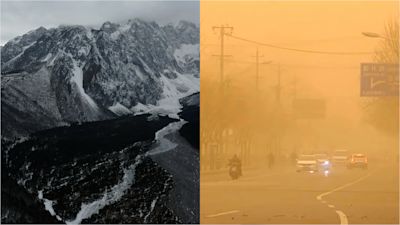China's climate change challenge: Complex, vast, and crucial to all of us

ITV News Asia Correspondent Debi Edward travelled to China's most at threat natural worlds
Footage courtesy of Greenpeace
From its shrinking glaciers, to its advancing desert and infamous smoggy cities. The climate change challenges facing China are complex and vast. It is both the world’s largest polluter and biggest producer of renewables infrastructure.
With President Xi putting himself front and centre at this Earth Day summit, setting ambitious targets and pledging to take a lead role in the global battle against climate change, the country sits a critical juncture attempting to reach global targets and meet domestic ambitions.
To adhere to the Paris Agreement, China would have to phase out coal before 2040, but the country is still building new coal plants, both at home and abroad.
It will require a monumental, and sudden, shift in energy provision and priorities to get close to the carbon targets it has signed up to.
The family living beneath China's melting glacier fear 'another earthquake'
While temperatures have risen by 1°C on average globally, in China they have gone up by 1.4°C - and that is proving devastating on its highest peaks.
We visited the Yulong Glacier in Yunnan Province, which is among the fastest retreating in the world. It has lost 60% of its mass in the past 40 years and it’s estimated to be eroding by 27 metres a year.
It is a majestic place to visit, aptly called the Jade Mountain in English, it sits on the edge of the Tibetan Plateau and is part of a glacier range often referred to as the Third Pole.
A huge region which also encompasses the Himalayas and contains the largest reserve of freshwater outside of the Arctic or Antarctic – the source for almost two billion people, more than a quarter of the world’s population.
Greenpeace has been monitoring the retreat of China's glaciers, and shared some images of the site taken almost ten years apart. They show a marked decline in the snow coverage.
The environmental campaign group believes that within the next 30 to 40 years the glacier here will disappear unless something can be done to halt rising temperatures. If the current trend continues then the millions living downstream from these glaciers will suffer from water shortages.
'Millions of people who live downstream from these glaciers will suffer'
Already China is facing a water crisis. It is home to 20% of the global population but has just 7% of the freshwater. It’s clear that imbalance is being exacerbated by climate change.
In recent months and years, the country has experienced extreme drought and flooding. The floods are caused in part by the increased run off from glaciers. That is expected to peak in 2030, and then the water shortages will take hold.
Desertification is another of China’s most pressing climate change concerns, a fifth of the country, mostly in the West, is classed as desert.
We travelled to Inner Mongolia where they have successfully arrested the advancing sands by planting millions of trees. The so-called Great Green Wall of China will eventually stretch almost 5000km and include 88 billion trees.
The planting projects also help mitigate greenhouse gases but clearly no amount of trees can counteract the country’s continued use of coal.
When it comes to meeting its climate change targets, China likes to state that it has further to go than any other nation.
It has taken decades of work to offset the environmental threats in the desert but now it must match that effort with urgent action to combat its carbon emissions.
A cleaner, greener China is vital in the global battle against climate change. The country has to act on its ambitions for the greater good of the world.